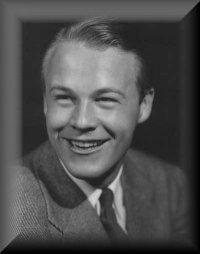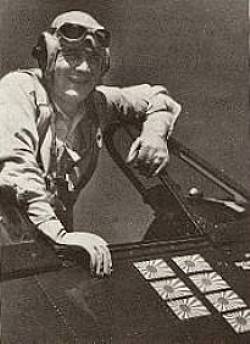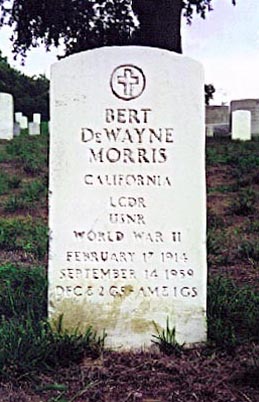American actor who had early success as a sunny juvenile, but whose career declined following World War II, in which he was a highly-decorated hero.
This photo was taken aboard USS ESSEX CV9 soon after Lt.Wayne Morris scored his 7th air victory.
Note: Wayne Morris was considered by the Navy as physically ‘to big’ to fly fighters. After being turned down several times as
a fighter pilot, he went to his brother in law, Commaneder David McCampbell, imploring him for the chance to fly fighters.
Commander McCampbell said “Give me a letter”. That’s how he became a fighter Ace. He flew with VF15 with the famed
“McCampbell Heroes”. Medal of Honor David McCampbell was the top Navy Ace of all time, with 34 air victories.This photo is from the Naval archives and is in the public domain.
A native of Los Angeles, Morris played football at Los Angeles City College, then worked as a forest ranger.
Returning to school, he studied acting at Los Angeles Junior College and at the acclaimed Pasadena Playhouse. A Warner Bros. talent scout spotted him at the Playhouse and he signed with the studio in 1936.
Blond and open-faced, he was a perfect type for boy-next-door parts and within a year had made a success in the title role of Kid Galahad (1937). While filming Flight Angels (1940), Morris became interested in flying and became a pilot.
With war in the wind, he joined the Naval Reserve and became a Navy flier in 1942, leaving his film career behind for the duration of the war. Assigned to the carrier Essex in the Pacific, Morris shot down seven Japanese planes and contributed to the sinking of five ships. He was awarded four Distinguished Flying Crosses and two Air Medals.
Following the war, Morris returned to films, but his nearly four-year absence had cost him his burgeoning stardom. He continued to topline movies, but the pictures, for the most part, sank in quality. Losing his boyish looks but not demeanor, Morris spent most of the Fifties in low-budget Westerns. A wonderful performance as a weakling in Stanley Kubrick’s Paths of Glory (1957) might have given impetus to a new career as a character actor, had Morris lived.
However, he suffered a massive heart attack while visiting aboard the aircraft carrier Bon Homme Richard in San Francisco Bay and was pronounced dead after being transported to Oakland Naval Hospital in Oakland, California. He was 45. His last film was not released until two years after his death.
Wayne Morris
Real name: Bert DeWayne Morris, Jr.
1914 – 1959
It’s a dubious distinction or honor, perhaps, but most Western film historians and fans generally agree that Wayne Morris was the last of the B-Western heroes, and TWO GUNS AND A BADGE (Allied Artists, 1954), was the last of the low-budget series Westerns. While this distinction may be questioned, there is no debating the fact that the big, likeable, laid-back actor was one of the true heroes of World War II.
Born on February 17, 1914 in Los Angeles, he attended Los Angeles High where he was a member of the cheerleading squad. Contrary to popular belief and probably studio hype, he did not play football. After graduating he attended Los Angeles City College before entering the famous Pasadena Playhouse on a scholarship. A screen test with Warner Brothers’ Studio led to a contract and a bit part as a navigator in the 1936 CHINA CLIPPER, an aviation yarn starring Pat O’Brien.
Other small roles followed between 1936 and 1937. His big break finally came in May of ’37 when the studio selected him for the title role in KID GALAHAD. Directed by Sam Bischoff, it was a major film with an impressive cast that included Bette Davis and Humphrey Bogart. In fact, KID GALAHAD is considered Morris’ best film and definitely boosted him to near-star status. That year also found Morris in his first Western, supporting Dick Foran in LAND BEYOND THE LAW.
Then came good performances in other roles including VALLEY OF THE GIANTS (’38), a Peter B. Kyne tale starring Chester Morris and Claire Trevor (two actors who would also become familiar with the Western genre) about lumberjacks and their many brawls.
Unfortunately, the following year, Morris would appear in only two films for the studio (THE KID FROM KOKOMO and THE RETURN OF DOCTOR X (which starred Bogart in the ludicrous role of Doctor X). Meanwhile, over at the Republic lot, changes were being made in their THREE MESQUITEERS’ lineup. John Wayne, who had replaced Robert Livingston for the ’38-’39 season, was moving up to bigger and better things (thanks, of course, to his starring role in STAGECOACH). This left a vacancy in the Stony Brooke role. Morris, interested in the role, and currently unsigned, inquired about the role, but to no avail. Discouraged, he then went back to Warner’s, who offered him another contract, which he signed. Republic then resigned Livingston for the role.
Then began one of Morris’s busiest seasons, appearing in seven titles, none of them Westerns. Of the seven, FLIGHT ANGELS (starring Dennis Morgan and Jane Wyman), undoubtedly set the stage for Wayne Morris’s future. During the shooting of the film, he took up flying lessons, a decision that would make a significant impact on his life.
Morris’ first Western of note came in 1941 in the Warner Brothers’ BAD MEN OF MISSOURI in which he plays one of the notorious Younger brothers.
With war clouds hanging over much of Europe and Asia, Morris became one of the first Hollywood actors to enter the service, joining the Naval Reserves and receiving a commission. Following flight training and a year as an instructor, he was thrust immediately in the Pacific air war, flying an F6F Hellcat off the carrier, the USS Essex. He would go on to fly 57 missions, shooting down seven Japanese aircraft, making him one of the early American aces of the war. Of the 57 missions he flew, three of his Hellcats were so full of holes when he returned to his carrier, they were rendered “unfit for duty” and dumped overboard.
Returning to Hollywood after the war, Morris attempted to pick up where he left off but things were not the same. He had difficulty getting roles; for some reason the studio kept him on ice for over a year before his next film appearance, on loan to Fox for the film, DEEP VALLEY, starring Ida Lupino and Dane Clark.
Back to Warner’s he began to receive good, co-starring roles in 1947-48 and in 1949 mounted up for his third Western, THE YOUNGER BROTHERS, another accounting of the outlaw brothers with Morris essaying the role of Cole in this one (he played Bob Cole in the ’41 film). Further adventure-type roles followed until 1951 when he returned to the Western genre again with star Rod Cameron for the routine but efficient Columbia oater, STAGE TO TUCSON.
Then came SIERRA PASSAGE for Monogram with a good cast featuring Lola Albright and I. Stanford Jolley (Jim Bannon, a former Red Ryder appeared briefly in the film). Closing out 1951 was YELLOWFIN (Monogram), and THE BUSHWHACKERS, a Jack Broder Western that starred John Ireland in his first starring role.
In 1952, Morris began his series of pictures for Monogram/Allied Artists, leading off with DESERT PURSUIT, an off-beat Western which takes place in Death Valley with Morris and ingénue Virginia Grey being chased by Arab-like characters on camels. Morris’ B-Western run officially began in December 1952 with TEXAS BADMAN, although STAR OF TEXAS (issued the following month) is often listed as the first of the series. A cut above the average B-Western, it was directed in documentary style by Lewis Collins and is unique in that no females are in the cast. As put by the late Don Miller in his unsurpassed HOLLYWOOD CORRAL, there was “no timeout for obligatory romantic byplay”. It was all action.
Still possessing an athletic build and the good looks of his earlier days, unfortunately, the years had taken its toll in the weight department, making him a little beefier than the average sagebrush hero. Nevertheless, he handled himself well in the action department and although doubled in most fight scenes, in close-ups he looked realistic enough throwing a punch. His Western garb was more on the conservative side and he forked a horse with no name, an average looking cayuse that he rode with more or less convincing ability.
Several of his Allied Artists’ pictures could be in the B-plus category rather than true, low-budgeted, formatted and programmed Westerns of the 30’s and 40’s. Running times were generally longer. THE DESPERADO (’54), next to last in the series ran for 82 minutes. THE FIGHTING LAWMAN (’53) clocked in at 71 minutes while STAR OF TEXAS (’53) and the last, TWO GUNS AND A BADGE (’54) were in the 68-69 minute range. The other two — TEXAS BADMAN (’52) and THE MARKSMAN (’53) — ran the standard 60-minute format. Of the six, THE DESPERADO is by far the strongest and best of the series.
The final film in the series, and considered the last B-Western produced, TWO GUNS AND A BADGE, released September 12, 1954, was more true to B-Western standards. Replete with a strong cast that includes Beverly Garland, Morris Ankrum, Roy Barcroft, and I. Stanford Jolley, it has ex-con Morris mistaken for a lawman who arrives in town to face corrupt rancher (Barcroft). It was the last gasp for the B-Western series and the end of an era that brought thrills and chills to millions of fans growing up in the 1930s-1950s.
Morris would return to Warner Brothers in 1954 to take second lead in the Randolph Scott, RIDING SHOTGUN and later that year travel to England where he made four films for release in the U.S. Throughout 1955, Morris would appear or star in several adventure-oriented films and for reasons unknown, was inactive the following year, or at least no credits have turned up. The following year he appeared in the somber and disturbing PATHS OF GLORY, the Stanley Kubrick directed story about an action in World War I.
Morris’ last screen appearance came in 1961 in BUFFALO GUN, a low-budget Globe production that featured singers Marty Robbins. Webb Pierce, and Carl Smith. It was not released until three years after it was filmed, and ironically, two years following Morris’ death.
In the late 50’s Morris, like so many other actors of the day, turned to the TV medium for work. From 1957 until his death, he appeared in a number of TV Westerns, and starred in an unsold TV pilot called THEY WENT THATAWAY.
Wayne Morris’ tragic death on September 14, 1959 at the age of 45 was a bizarre and ironic one. While visiting his old wartime commander and watching aerial maneuvers on the bridge of a carrier off the coast of Monterey, he collapsed and died of a heart attack. He was buried at Arlington National Cemetery with full military honors. His younger brother, Richard, a B-17 pilot shot down during WWII, also reposes at Arlington.
Whether or not Wayne Morris was the last of the B-Western heroes is irrelevant and of little consequence when you consider the role he played in WW II. That is the one Americans should never forget.
Morris was married to the former Patricia O’Rourke, an Olympic swimmer and sister of Republic star, Peggy Stewart.
MORRIS, BERT DEWAYNE
LT CDR USNR
- DATE OF BIRTH: 02/17/1914
- DATE OF DEATH: 09/14/1959
- BURIED AT: SECTION 8 SITE 5491 LH
- ARLINGTON NATIONAL CEMETERY
MORRIS, RICHARD B
2ND LT 334 SQD 95 BOMB GP AAF USA WW II
- DATE OF BIRTH: 10/02/1922
- DATE OF DEATH: 02/03/1945
- BURIED AT: SECTION 8 SITE 5493 RH
- ARLINGTON NATIONAL CEMETERY
Michael Robert Patterson was born in Arlington and is the son of a former officer of the US Army. So it was no wonder that sooner or later his interests drew him to American history and especially to American military history. Many of his articles can be found on renowned portals like the New York Times, Washingtonpost or Wikipedia.
Reviewed by: Michael Howard



